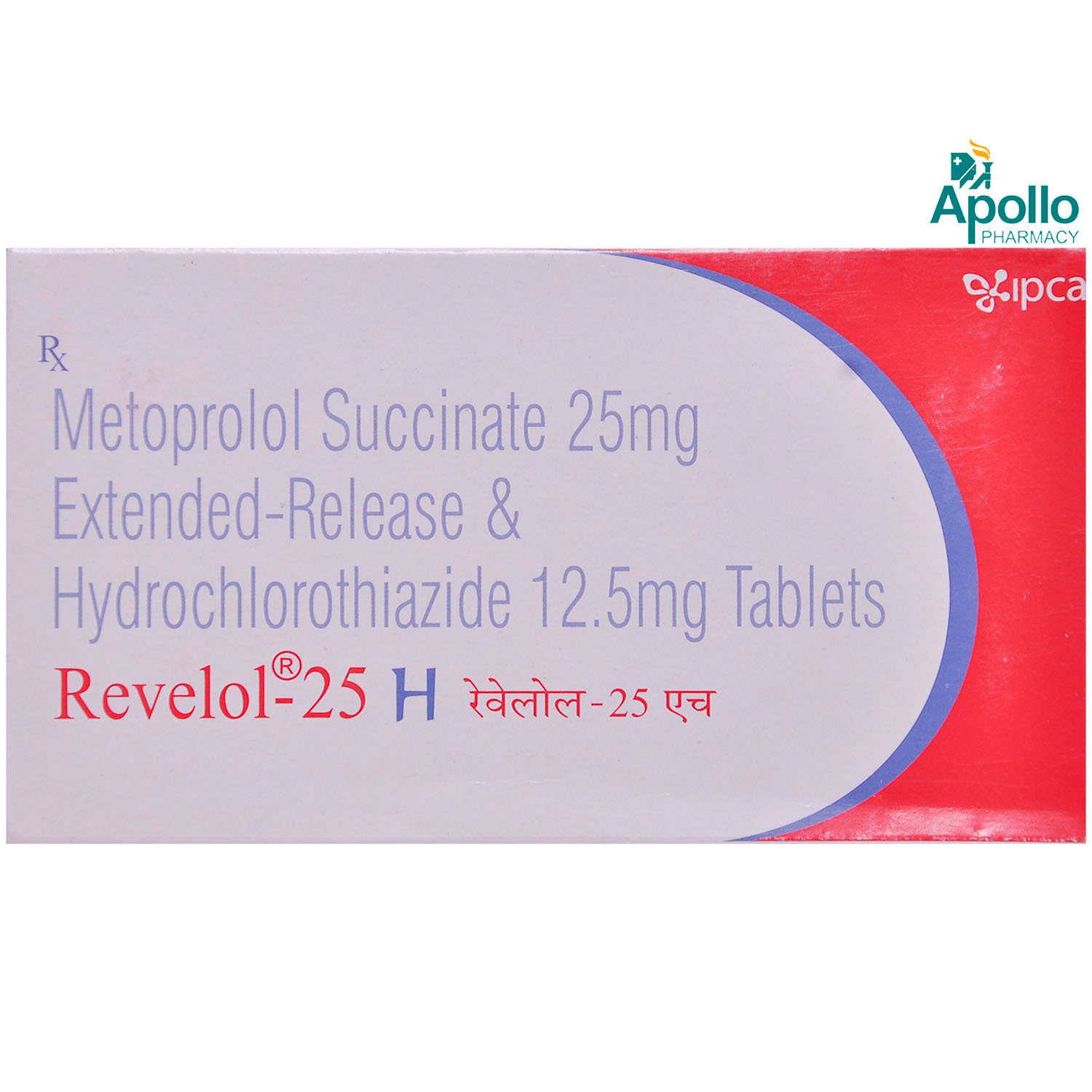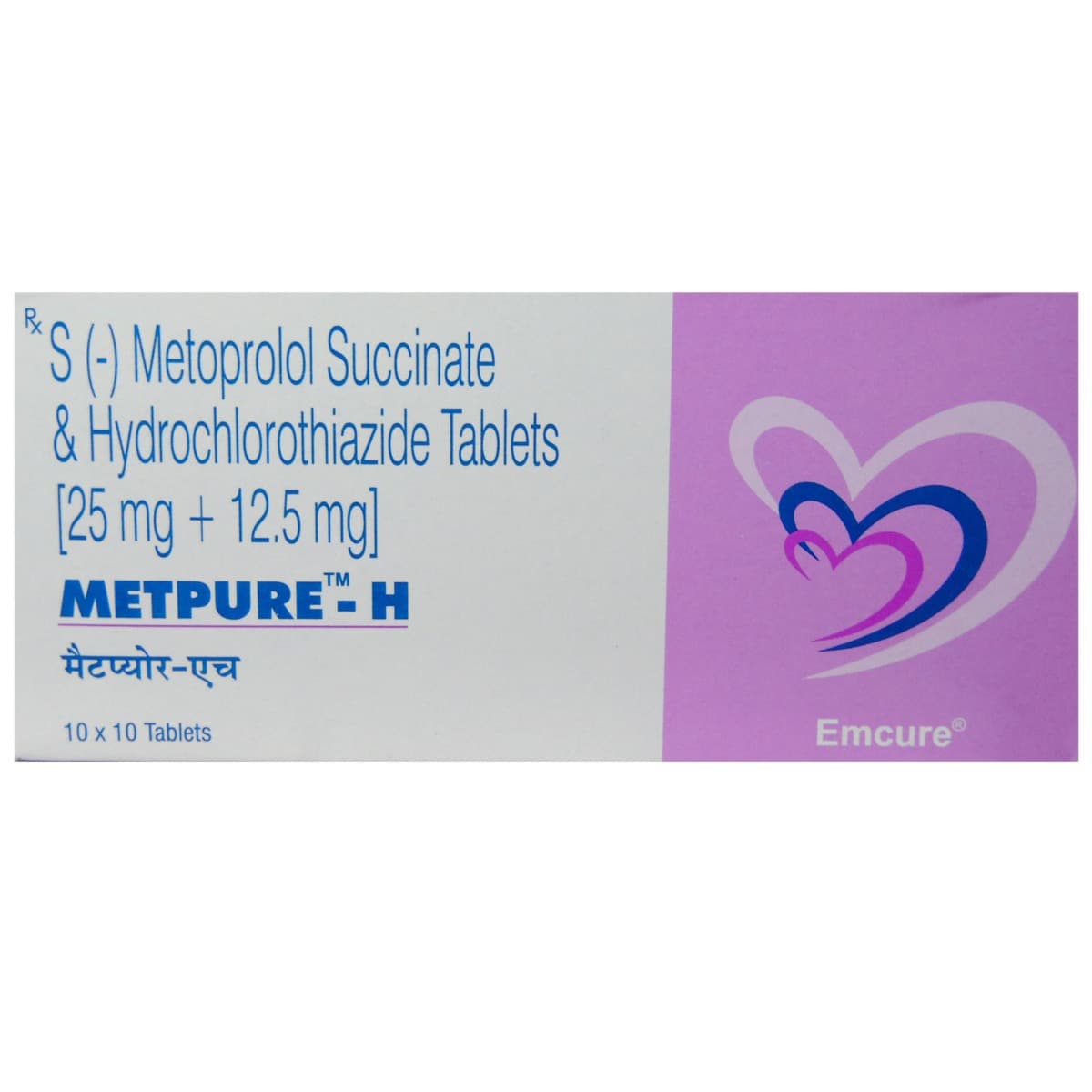Starpress H 25 XL Tablet

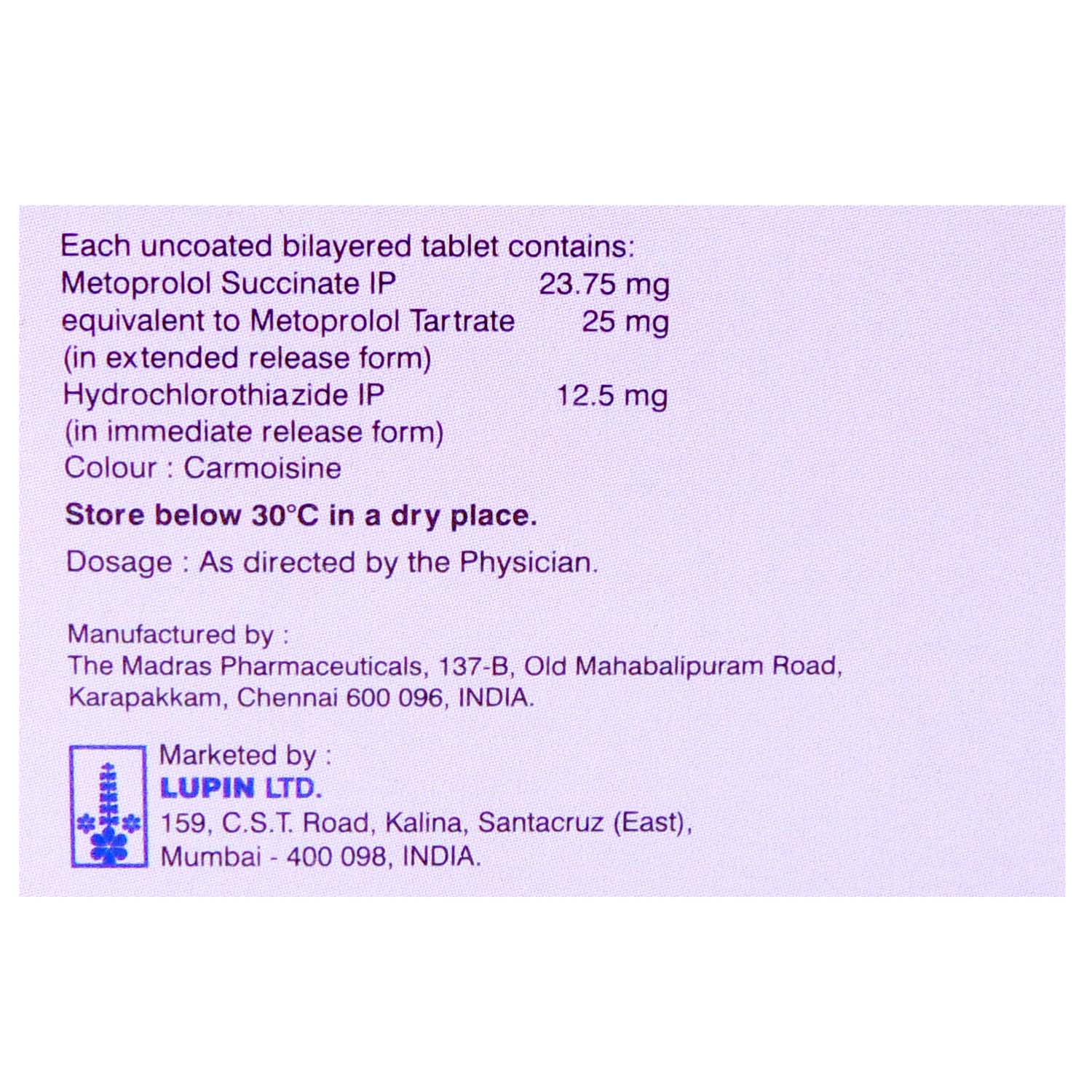
MRP ₹97
(Inclusive of all Taxes)
₹14.6 Cashback (15%)
know your delivery time
Provide Delivery Location
Composition :
Manufacturer/Marketer :
Consume Type :
Expires on or after :
Return Policy :

Secure Payment

Trusted by 8 Crore Indians

Genuine Products
Therapeutic Class
Country of origin
Manufacturer/Marketer address
Author Details
We provide you with authentic, trustworthy and relevant information
Disclaimer
Alcohol
Safe if prescribed
Drinking alcohol may increase tiredness, lower blood pressure causing dizziness or drowsiness. So avoid its intake with Starpress H 25 XL Tablet
Pregnancy
Consult your doctor
Starpress H 25 XL Tablet is a pregnancy category C drug. It is not recommended during pregnancy unless your doctor considers it essential. Your doctor will weigh the benefits and any potential risks before prescribing it to you.
Breast Feeding
Consult your doctor
Small amounts of Starpress H 25 XL Tablet passes into the breast milk. However which is not enough to cause any problems to your baby. But, still, it is advisable to contact your doctor before breastfeeding your baby.
Driving
Safe if prescribed
You may experience dizziness, tiredness, or blurred vision while taking Starpress H 25 XL Tablet . So, it is not recommended to drive, use machinery, or perform other tasks.
Liver
Consult your doctor
Starpress H 25 XL Tablet should be used with caution in patients with impaired hepatic function or progressive liver disease since minor alterations of fluid and electrolyte balance may precipitate hepatic coma. Your doctor may adjust your dose depending upon your current liver conditions.
Kidney
Consult your doctor
Starpress H 25 XL Tablet to be taken with caution, especially if you have had a history of kidney disease. Your doctor will have to change the dosage depending on your medical condition and your reaction to treatment.
Children
Safe if prescribed
The safety and efficacy of Starpress H 25 XL Tablet in children have not been established. Starpress H 25 XL Tablet is not recommended in children.
Product Substitutes
About Starpress H 25 XL Tablet
Starpress H 25 XL Tablet belongs to the class of anti-hypertensives, primarily taken to treat hypertension (high blood pressure) and reduce stroke risk in patients with high blood pressure. Starpress H 25 XL Tablet is a combination medication generally used when a single medicine is unable to control high blood pressure. Hypertension or high blood pressure is a life-long or chronic condition in which the force exerted against the artery wall becomes too high. It can lead to the risk of heart diseases like heart attack and stroke.
Starpress H 25 XL Tablet is a combination of two medicines: Metoprolol and Hydrochlorothiazide. Metoprolol belongs to the class of drugs known as β-blockers that works by relaxing the blood vessels by blocking the action of certain natural substances in your body. It helps slow down the heart rate, making it easier to pump more blood around your body and lower blood pressure. On the other hand, Hydrochlorothiazide is a diuretic or water pill that works by removing extra water/fluid and certain electrolyte overload from the body. Together, Starpress H 25 XL Tablet lowers fluid overload, raises blood pressure, improves blood flow, and reduces the future risk of a heart attack and stroke. This medicine needs to be taken regularly to be effective.
Take Starpress H 25 XL Tablet as prescribed by your doctor. Depending on your medical conditions, you are advised to take Starpress H 25 XL Tablet for as long as your doctor has prescribed it for you. You may experience nausea, fatigue, constipation, diarrhoea, headache, dizziness, increased blood uric acid, slow heart rate, decreased potassium level in the blood, altered blood lipid level, glucose intolerance, increased calcium level in the blood, and decreased magnesium level in blood. Most of these side effects of Starpress H 25 XL Tablet do not require medical attention and gradually resolve over time. However, if the side effects are persistent, reach out to your doctor.
Inform your doctor if you have had an allergic reaction to Starpress H 25 XL Tablet , have liver disease, kidney disease, asthma, heart failure, a heart valve problem, or have a history of a heart attack. Pregnant and breastfeeding women should consult their doctor before taking Starpress H 25 XL Tablet . Orthostatic hypotension (sudden lowering of blood pressure) might occur, so patients taking Starpress H 25 XL Tablet should get up with caution. A prolonged intake of Starpress H 25 XL Tablet may decrease your blood potassium levels. So, it is better to ask your doctor about foods high in potassium, like bananas or orange juice. Regular monitoring of blood pressure, kidney function, and electrolyte (sodium, potassium, calcium, etc.) are recommended while taking Starpress H 25 XL Tablet . And also, a healthy diet and regular exercise are necessary to keep blood pressure under control.
Uses of Starpress H 25 XL Tablet
Medicinal Benefits Mweb
Key Benefits
Starpress H 25 XL Tablet contains a combination of medicines: Metoprolol (beta-blockers) and Hydrochlorothiazide (thiazide diuretic or water pill). Metoprolol plays a vital role in relaxing our blood vessels by blocking the action of certain natural substances in our bodies. It helps slow down the heart rate, making it easier to pump more blood around your body and lower blood pressure. Hydrochlorothiazide is a diuretic that prevents excess salt absorption in the body, preventing fluid retention. Collectively, both help reduces blood pressure and the chance of a stroke, heart attack, and oedema (fluid overload).
Directions for Use
Side Effects of Starpress H 25 XL Tablet
- Nausea
- Fatigue
- Headache
- Dizziness
- Diarrhoea
- Stuffy nose, sore throat
- Slow heart rate
- Increased blood uric acid
- Decreased potassium/ magnesium level in the blood
- Increased calcium level in the blood
- Altered blood lipid level
- Glucose intolerance
Drug Warnings
Don't stop taking Starpress H 25 XL Tablet without talking to your doctor first. Stopping Starpress H 25 XL Tablet gradually may cause changes in your heart rhythm and blood pressure, cause chest pain, or a heart attack. Your doctor will lower your dose gradually over a period of time to help prevent these symptoms. You should not use Starpress H 25 XL Tablet if you have allergic to Starpress H 25 XL Tablet , have low blood pressure (less than 90 mm of Hg), very slow heartbeat, serious lung condition (like asthma), serious heart condition (sick sinus syndrome), or any heart blockage. Do not use Starpress H 25 XL Tablet if you are pregnant, planning for pregnancy, breastfeeding, or unable to urinate (anuria). It should not be given to the children as safety and effectiveness have not been established. Before taking Starpress H 25 XL Tablet you should tell the doctor if you have any muscle disorder (myasthenia gravis, rhabdomyolysis), breathing problem (COPD, bronchitis, emphysema), low blood sugar level (hypoglycemia), eye problem (glaucoma), low blood pressure (hypotension), depression, previous heart failure, liver/kidney disease, thyroid hormone disorder like overactive thyroid (hyperthyroidism), adrenal gland cancer, or severe blood circulation problem (Raynaud’s syndrome). You should monitor your blood pressure regularly to make sure the Starpress H 25 XL Tablet is working efficiently. Besides this, prolonged intake of Starpress H 25 XL Tablet can lead to lowering of blood pressure (hypotension). So, daily monitoring of blood pressure is advisable.
Drug-Drug Interactions
Drug-Drug Interactions
Login/Sign Up
Taking Cisapride and Starpress H 25 XL Tablet can increase the risk of an irregular heart rhythm which can be severe. The risk increases in patients with a history of heart illness or electrolyte imbalance.
How to manage the interaction:
Combining Cisapride and Starpress H 25 XL Tablet together is generally avoided as it can possibly result in an interaction, it can be taken if advised by your doctor. However, if you experience any symptoms like dizziness, lightheadedness, fainting, or fast or pounding heartbeats, consult the doctor immediately. Do not stop using any medications without a doctor's advice.
Taking Dofetilide and Starpress H 25 XL Tablet can increase the risk of an irregular heart rhythm which can be severe. The risk increases in patients with a history of heart illness or electrolyte imbalance.
How to manage the interaction:
Combining Dofetilide and Starpress H 25 XL Tablet together is not recommended as it can possibly result in an interaction, it can be taken if advised by your doctor. However, if you experience any symptoms like sudden dizziness, lightheadedness, fainting, shortness of breath, chest pain or tightness, rapid heartbeat, or memory loss, contact your doctor immediately. Do not discontinue any medications without consulting a doctor.
Coadministration of Amiodarone together with Starpress H 25 XL Tablet may raise the risk of an abnormal heart rhythm.
How to manage the interaction:
Even though Amiodarone and Starpress H 25 XL Tablet interact, they can be used if prescribed by a doctor. If you have cardiac problems or electrolyte imbalances, you may be at greater risk. If you experience abrupt dizziness, lightheadedness, fainting, shortness of breath, or rapid heartbeat, Weakness, tiredness, drowsiness, confusion, painful muscle cramping, dizziness, nausea, or vomiting, get medical attention. Do not discontinue any medications without consulting a doctor.
The combined use of Tizanidine and Starpress H 25 XL Tablet can have additive effects in lowering your blood pressure.
How to manage the interaction:
Taking Tizanidine and Starpress H 25 XL Tablet together can possibly result in an interaction, but they can be taken if advised by your doctor. However, if you experience any symptoms like headache, dizziness, lightheadedness, fainting, and changes in pulse or heart rate, consult a doctor immediately. Do not stop using any medications without a doctor's advice.
Co-administration of Dronedarone and Starpress H 25 XL Tablet can increase the risk of severe irregular heart rhythm which can be severe. The risk increases in patients with a history of heart illness or electrolyte imbalance.
How to manage the interaction:
Taking Dronedarone and Starpress H 25 XL Tablet together is avoided as it can possibly result in an interaction, it can be taken if advised by your doctor. However, if you experience any symptoms like dizziness, lightheadedness, fainting, fast heartbeats, weakness, tiredness, drowsiness, confusion, muscle pain, cramps, nausea, or vomiting, consult the doctor immediately. Do not stop using any medications without a doctor's advice.
Co-administration of Droperidol and Starpress H 25 XL Tablet can increase the risk of an irregular heart rhythm which can be severe. The risk increases in patients with a history of heart illness or electrolyte imbalance.
How to manage the interaction:
Taking Droperidol and Starpress H 25 XL Tablet together can possibly result in an interaction, but they can be taken if advised by your doctor. However, consult the doctor immediately if you experience any symptoms like dizziness, lightheadedness, fainting, fast heartbeats, weakness, tiredness, drowsiness, confusion, muscle pain, cramps, nausea, or vomiting. Do not stop using any medications without a doctor's advice.
Taking Ziprasidone and Starpress H 25 XL Tablet can increase the risk of an irregular heart rhythm which can be severe. The risk increases in patients with a history of heart illness or electrolyte imbalance.
How to manage the interaction:
Taking Ziprasidone and Starpress H 25 XL Tablet together is avoided as it can possibly result in an interaction, but it can be taken together if prescribed by a doctor. However, consult your doctor if you experience sudden dizziness, lightheadedness, fainting, shortness of breath. Do not discontinue any medications without consulting a doctor.
Coadministration of Aminolevulinic acid with Starpress H 25 XL Tablet can make your skin more sensitive to bright lights. This could increase the risk or severity of developing a sunburn.
How to manage the interaction:
Although there is a possible interaction between Aminolevulinic acid and Starpress H 25 XL Tablet, it can be taken if advised by your doctor. Avoid exposure of the eyes and skin to sunlight or bright indoor lights for 48 hours. Do not stop using any medications without a doctor's advice.
Coadministration of Lithium and Starpress H 25 XL Tablet can increase the effects of lithium.
How to manage the interaction:
Taking Lithium and Starpress H 25 XL Tablet together can possibly result in an interaction, but it can be taken if advised by your doctor. However, if you experience any symptoms like loose stools, vomiting, drowsiness, shaking of hands and legs, thirst, increased urination, lack of coordination, or muscle weakness, consult the doctor immediately. Do not stop using any medications without a doctor's advice.
Co-administration of Arsenic trioxide and Starpress H 25 XL Tablet can increase the risk of an irregular heart rhythm which can be severe. The risk increases in patients with a history of heart illness or electrolyte imbalance.
How to manage the interaction:
Taking Arsenic trioxide and Starpress H 25 XL Tablet together is avoided as it can possibly result in an interaction, it can be taken if advised by your doctor. However, if you experience any symptoms like dizziness, lightheadedness, fainting, fast heartbeats, weakness, tiredness, drowsiness, confusion, muscle pain, cramps, nausea, or vomiting. consult the doctor immediately. Do not stop using any medications without a doctor's advice.
Drug-Food Interactions
Drug-Food Interactions
Login/Sign Up
Drug-Diseases Interactions
Drug-Diseases Interactions
Login/Sign Up
Drug-Drug Interactions Checker List
- ACEBUTOLOL
- ATENOLOL
- BISOPROLOL
- CARTEOLOL
- ESMOLOL
- NADOLOL
- LISINOPRIL
- ENALAPRIL
- DILTIAZEM
- PRAZOSIN
- TERAZOSIN
- RAMIPRIL
- ATORVASTATIN
- FUROSEMIDE
- CHLOROTHIAZIDE
- CHLORTHALIDONE
- INDAPAMIDE
- METOLAZONE
- THEOPHYLLINE
- AMINOPHYLLINE
- IBUPROFEN
- ASPIRIN
- TERBINAFINE
- ALDESLEUKIN
- DIPYRIDAMOLE
- RIFAMPICIN
- RITONAVIR
- DIPHENHYDRAMINE
- AMIODARONE
- PROPAFENONE
- QUINIDINE
- DISOPYRAMIDE
- PROCAINAMIDE
- FLECAINIDE
- DIGOXIN
- LIDOCAINE
- CARBAMAZEPINE
- PHENOBARBITAL
- CYCLOSPORINE
Habit Forming
Diet & Lifestyle Advise
- Consume antioxidant-rich food. Blueberries, cherries, tomatoes, squash, and bell peppers are high in antioxidants.
- Eat natural diuretic foods. Asparagus, beets, green beans, grapes, onion, leafy greens, pineapple, leeks, pumpkin, and garlic are all-natural diuretic foods.
- Use healthy cooking oils like soybean, olive, canola, and coconut oil.
- You should avoid refined foods such as white bread, spaghetti, sugar, and red meat.
- Reduce or eliminate Trans fatty acids, which are found in commercially baked items such as cookies, cakes, crackers, French fries, onion rings, doughnuts, and processed foods.
- Avoid the consumption of too much salt or salty food.
- Keep your weight under control with a BMI of 19.5-24.9.
- Regular physical activity or exercise like walking improves your blood flow.
- When possible, elevate your legs or the swollen area on a chair or pillows.
- Avoid standing or sitting for extended periods of time.
- Avoid chronic stress as it can raise your blood pressure.
- Spend time with your loved ones to cope with stress and practice mindfulness techniques.
- Quitting smoking and alcohol consumption is the best strategy to lower the risk of many health complications.
All Substitutes & Brand Comparisons
RX
Out of StockMETOCARD H 25MG TABLET
Torrent Pharmaceuticals Ltd
₹28.17
(₹2.54 per unit)
70% CHEAPERRX
Out of StockMetomac-H 25 mg Tablet 10's
Macleods Pharmaceuticals Ltd
₹38.61
(₹3.48 per unit)
60% CHEAPERRX
Out of StockMETO ER HT 25MG TABLET
Mano Pharma
₹67.8
(₹6.1 per unit)
30% CHEAPER

Have a query?
Buy best Cardiology products by
Torrent Pharmaceuticals Ltd
Sun Pharmaceutical Industries Ltd
Lupin Ltd
Intas Pharmaceuticals Ltd
Cipla Ltd
Micro Labs Ltd
Macleods Pharmaceuticals Ltd
Abbott India Ltd
Ajanta Pharma Ltd
Ipca Laboratories Ltd
Eris Life Sciences Ltd
Mankind Pharma Pvt Ltd
Lloyd Healthcare Pvt Ltd
Dr Reddy's Laboratories Ltd
Glenmark Pharmaceuticals Ltd
Emcure Pharmaceuticals Ltd
Alembic Pharmaceuticals Ltd
Alkem Laboratories Ltd
East West Pharma India Pvt Ltd
USV Pvt Ltd
Zydus Healthcare Ltd
Aristo Pharmaceuticals Pvt Ltd
Elbrit Life Sciences Pvt Ltd
J B Chemicals & Pharmaceuticals Ltd
Zydus Cadila
Akumentis Healthcare Ltd
Alteus Biogenics Pvt Ltd
Hbc Life Sciences Pvt Ltd
Fusion Health Care Pvt Ltd
Troikaa Pharmaceuticals Ltd
La Renon Healthcare Pvt Ltd
Corona Remedies Pvt Ltd
Jubilant Lifesciences Ltd
Medley Pharmaceuticals Ltd
Knoll Healthcare Pvt Ltd
Msn Laboratories Pvt Ltd
Zuventus Healthcare Ltd
Cadila Pharmaceuticals Ltd
Blue Cross Laboratories Pvt Ltd
Lividus Pharmaceuticals Pvt Ltd
Morepen Laboratories Ltd
Ranmarc Labs
Shrrishti Health Care Products Pvt Ltd
Sanofi India Ltd
Steris Healthcare
Elder Pharmaceuticals Ltd
Primus Remedies Pvt Ltd
Unison Pharmaceuticals Pvt Ltd
Eswar Therapeutics Pvt Ltd
Knoll Pharmaceuticals Ltd
Tas Med India Pvt Ltd
Systopic Laboratories Pvt Ltd
Indiabulls Pharmaceuticals Pvt Ltd
Leeford Healthcare Ltd
Sinsan Pharmaceuticals Pvt Ltd
Biochem Pharmaceutical Industries Ltd
Cadila Healthcare Ltd
Azkka Pharmaceuticals Pvt Ltd
Nirvana India Pvt Ltd
Orsim Pharma
Prevego Healthcare & Research Pvt Ltd
Econ Healthcare
Elinor Pharmaceuticals (P) Ltd
FDC Ltd
Sunij Pharma Pvt Ltd
Nicholas Piramal India Ltd
Astra Zeneca Pharma India Ltd
Pfizer Ltd
Lia Life Sciences Pvt Ltd
Shine Pharmaceuticals Ltd
Elicad Pharmaceuticals Pvt Ltd
Indoco Remedies Ltd
Proqol Health Care Pvt Ltd
Vasu Organics Pvt Ltd
Biocon Ltd
Opsis Care Lifesciences Pvt Ltd
Johnlee Pharmaceuticals Pvt Ltd
Merck Ltd
Wockhardt Ltd
Auspharma Pvt Ltd
Ergos Life Sciences Pvt Ltd
Lakshya Life Sciences Pvt Ltd
Ordain Health Care Global Pvt Ltd
Pficus De Med Pvt Ltd
ALICAN PHARMACEUTICAL PVT LTD
RPG Life Sciences Ltd
Glynis Pharmaceuticals Pvt Ltd
Orris Pharmaceuticals
Samarth Life Sciences Pvt Ltd
Aprica Pharmaceuticals Pvt Ltd
Aretaeus Pharmaceuticals Pvt Ltd
Koye Pharmaceuticals Pvt Ltd
Neocardiab Care
Retra Life Science Pvt Ltd
Alniche Life Sciences Pvt Ltd
Alvio Pharmaceuticals Pvt Ltd
Arkas Pharma Pvt Ltd
Atos Lifesciences Pvt Ltd
Divine Savior Pvt Ltd
Metalis Lifesciences Pvt Ltd
Customers Also Bought
Recommended for a 30-day course: 3 Strips




